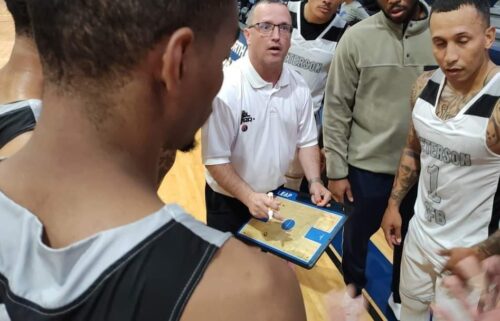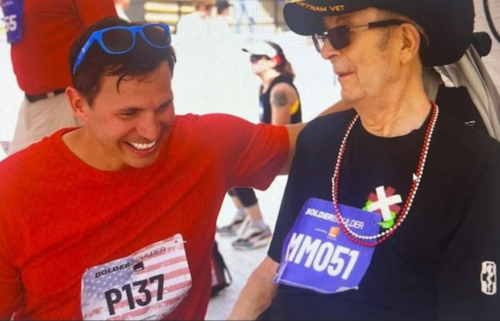Hello Kitty at 50: The mouthless face that launched an $80 billion empire
By Oscar Holland, Hanako Montgomery and Junko Ogura, CNN
(CNN) — She weighs three apples and stands five apples tall. She enjoys baking cookies and dreams of being a pianist or poet. And now, despite her ageless appearance, she is 50 years old.
Friday marks half a century since Japanese merchandising company Sanrio created the first iteration of Kitty White, or Hello Kitty, a cheerful feline girl (not, as her creator controversially revealed in 2014, a cat) who lives with her family in London’s suburbs. In the decades since debuting, she has become a UNICEF ambassador, a special envoy for Japan’s Foreign Ministry and the subject of themed restaurants, cafes, two amusement parks and even a maternity hospital.
As such, Hello Kitty is also a commercial behemoth that has earned her creator an estimated $80 billion, placing her alongside Pokémon, Mickey Mouse and Winnie-the-Pooh as history’s top-grossing franchises. Unlike others on the list, however, merchandise wasn’t a profitable extension of Hello Kitty’s on-screen popularity — it was her raison d’être from the start.
Designed to adorn children’s items and stationery, she was first drawn by Yuko Shimizu, one of Sanrio’s in-house illustrators, in 1974. The company wanted designs embodying “kawaii,” a Japanese term for cuteness, and the 24-year-old’s cat-like creation was inspired by a kitten her father had given her as a gift. Hello Kitty made her commercial debut the next year, appearing on a line of vinyl coin purses alongside several other new characters.
She proved, by far, to be the company’s most popular new design. Sanrio’s sales soared almost immediately as her image was pasted onto toys, stickers and much else. But if the character’s early success can be attributed to Shimizu’s simple, memorable design — comprising a mouthless face, oval yellow nose, whiskers and a bow — her status as a pop culture icon is thanks to illustrator Yuko Yamaguchi.
Considered Hello Kitty’s third designer (Shimizu left Sanrio three years after inventing the character and was replaced by Setsuko Yonekubo, who briefly oversaw the design in the late 1970s) Yamaguchi has steered the character’s visual identity for almost 45 years. Speaking to CNN at Sanrio’s Tokyo headquarters, she recalled joining the company at a time when Hello Kitty products were declining in popularity.
In 1979, Sanrio decided to revitalize the brand, and Yamaguchi was one of several illustrators tasked with creating and presenting new imagery. Aware that Hello Kitty was an aspiring musician, she drew a scene envisaging the character surrounded by her family after receiving her first grand piano.
“Even though Hello Kitty says she wants to be a pianist, she had never been depicted playing the piano,” she said, adding: “I was asked to be the designer of Hello Kitty on the spot.”
Yamaguchi started meeting with Hello Kitty’s fans, past and present, to understand why sales were down. She also made a formative year-long visit to San Francisco in 1984, amid a booming US interest in teddy bears. After returning to Japan, Yamaguchi began creating new drawings and a cast of friends for Hello Kitty — including the teddy bear, Tiny Chum.
“I wanted Hello Kitty to become more energetic,” she said. “And since she was the face of Sanrio, and was born as a symbol of friendship, I wanted to make lots of friends for her.”
Subtle evolution
While Hello Kitty’s key features remained largely unchanged, Yamaguchi (who previously told Time magazine that the character doesn’t have a mouth “so that people who look at her can project their own feelings onto her face”) placed her in different scenarios, broadening her appeal.
“She’s good at sports, and she looks cute and chic too,” she explained. “I think of her as a blank canvas that you can transform into all sorts of things. There’s not much that doesn’t suit her… I think that when everyone talks to Hello Kitty, she probably answers them in some way.”
Sales of Hello Kitty products flourished in Japan between the 1980s and mid-1990s. Much of the company’s earlier merchandise was aimed at young girls, including school supplies and personal care items like toothbrushes. But, even then, illustrator Yamaguchi knew the character would need to evolve and grow with her fans.
It’s a realization the illustrator traces back to a letter she received from a fan in 1987: “She was a big fan of Hello Kitty but, in the letter, she wrote that her friends and parents had told her that it is a children’s character, and that she should have outgrown it. But she didn’t want to, so she asked me to make products for high school students like her.”
Inspired by the trends she saw in Tokyo’s Harajuku fashion district at the time, Yamaguchi began incorporating contemporary style into her designs, in the hope of appealing to older fans. In 1999, Sanrio told the New York Times that the character was appearing on 12,000 new product lines a year, spanning almost every category imaginable, from clothing to board games, greeting cards to lunchboxes. The company also began using Hello Kitty on more adult items, like electronics and kitchen appliances, as it became clear that nostalgia was becoming a major selling point.
As a result, some of today’s biggest Hello Kitty fans are those who grew up with her in the 1980s and ‘90s. Among them is Asako Kanda, who started collecting Sanrio products in third grade and now owns over 10,000 items adorned with the character’s expressionless face.
“My mother gave me Hello Kitty stationery and school supplies like pencil cases and plastic boards. When I saw them, I thought they were so cute, and they quickly became my favorite. That’s where it started,” she said, showing CNN around a dedicated Hello Kitty room in her Tokyo home. “Once I began buying things for myself, I could get items for the kitchen, bathroom and other daily necessities. I wanted to unify everything with Hello Kitty from that point on.
After more than 36 years of collecting, Kanda still buys around two Hello Kitty items every month. Sanrio releases new products on a weekly basis, and she scans them looking for anything that is “memorable or cute.”
“As life goes on, there are times when you face unpleasant or sad experiences,” she said, “During those times, looking at Hello Kitty goods have brought me comfort and solace.”
Going global
As Japan’s economy stagnated in the 1990s, Sanrio expanded its international presence. In Hello Kitty’s early years, the company had sold products door-to-door in the US, before setting up the first overseas branch of its retail store, Gift Gate, in San Jose in 1976. But following an explosion of Western interest in Japanese culture — from “Dragon Ball Z” to Tamagotchis and Beyblade — she captured the imagination of American consumers around the turn of the millennium, according to Atsuo Nakayama, a Japanese sociologist specializing in the entertainment industry.
“Just after 9/11, the world was changing,” he told CNN. “And I think that the Japanese ‘kawaii’ culture was an alternative fit for America, somehow.”
Much of Hello Kitty’s commercial success has been achieved through licensing. She has spawned books, video games and animated TV series, like the long-running “Hello Kitty and Friends,” which helped further develop her character. (Although, despite being raised in London, she was given a North American accent in English dubbed versions.) She has also been part of deals with major consumer and luxury brands, and has appeared on an EVA Air plane, Fender Stratocaster guitars and Swarovski jewelry.
And while Sanrio’s declining fortunes at the turn of the 2010s sparked fears that Hello Kitty’s cultural relevance was fading, the company’s share price has rocketed in the last two years. It now stands over 10 times its Covid-era low. According to Atsuo, nostalgia is once again a key driving force — at home in Japan, and abroad.
“Hello Kitty is on the rise again in America, and I think that this is because the first generation have now become parents and passed (their interests) on to their children,” Atsuo said, adding: “(Her popularity) has risen and fallen many times like this, and it creates a regular opportunity for people who were captivated by Hello Kitty to remember it and want to collect it again.”
Sanrio’s recent successes are also, in part, due to it diversifying away from Hello Kitty. The character now only accounts for around 30% of Sanrio’s gross profit in product sales and licensing, down from 76% a decade earlier, according to the Wall Street Journal. Recent creations like Gudetama (a lazy egg yolk) and Aggressive Retsuko (an introverted death-metal-loving red panda) have both featured in their own Netflix series.
Yet, even as Sanrio’s business model changes, Yamaguchi believes Hello Kitty will endure.
“Of course, there are many characters in the world that have been around longer than Hello Kitty,” the illustrator said, adding: “I hope she continues working hard so she can celebrate her 100th anniversary in 50 years’ time.”
The-CNN-Wire
™ & © 2024 Cable News Network, Inc., a Warner Bros. Discovery Company. All rights reserved.
CNN’s Genta Takeda contributed to this story.



